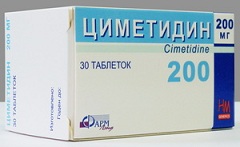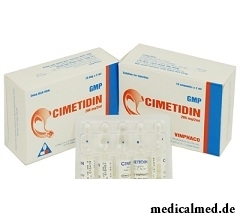





Cimetidinum
Application instruction:
Pharmacological action of Cimetidinum
Cimetidinum is the lock histamine H2 receptors. Suppresses production of hydrochloric acid, stimulated food, gastrin, a histamine and acetylcholine. Reducing the level of hydrochloric acid, increases the pH level and lowers activity of pepsin.
Cimetidinum starts the protective mechanism mucous a stomach, heals the damages caused by effect of hydrochloric acid. Reduces concentration of P450 cytochrome. Does not exert impact on adrenoceptors, has no anesthetic effect. After reception of Cimetidinum in inside therapeutic effect comes in 1 hour and 4-5 hours continue to work.
Pharmacokinetics
Cimetidinum is completely soaked up from digestive tract. Metabolism happens at "the first passing". Bioavailability of drug – 60-70%. The maximum concentration in a blood plasma, at reception next the heart, is reached in 1 hour, in 3 hours the second peak can be observed. Cimetidinum is distributed in body tissues. Level of linkng with proteins of plasma – 20%.
Cimetidinum elimination half-life – about 2 hours, at dysfunction of kidneys can increase. It is removed generally in an invariable view with urine. The clearance of Cimetidinum increases at the patients who got burns.
Cimetidinum dosage
The instruction of Cimetidinum recommends to establish a dosage proceeding from the general condition of the patient. To adult patients the single dose makes 100-800 mg.
At intravenous administration of Cimetidinum the single dose is equal to 200 mg, at intravenous infusion – 400 mg. The most admissible daily dose irrespective of a method of introduction should not exceed 2 g.
The most admissible dose of Cimetidinum for children of 1 year is also more senior irrespective of a way of introduction – 25-30 mg/kg/days separate doses. To children is younger than one year – 20 mg/kg/days.
Interaction of Cimetidinum with other drugs
The concomitant use with the antacids containing aluminum hydroxide and magnesium hydroxide can lead to decrease in absorption of Cimetidinum. At a combination to sulphonylurea derivatives – hypoglycemic means – sometimes observe a hypoglycemia.
Cimetidinum combinations to chlordiazepoxide, clorazepate, triazolamy, alprazolamy, diazepam, klobazamy, nitrazepam, flurazepam leads to increase in concentration of benzodiazepines in a blood plasma. Can strengthen sedative action.
Simultaneous use increases concentration of Amiodaronum in blood, because of delay of his metabolism.
Cimetidinum combination with atenololy in certain cases causes the expressed bradycardia.
At a concomitant use with benzylpenicillin increases its bioavailability.
The concomitant use with a vekuroniya chloride, verapamil, gallopamily strengthens effect of these drugs.
The combination to indometacin leads to decrease in its concentration in a blood plasma, without influence on its antiinflammatory effect.
The combination with ketokonazoly and itrakonazoly reduces their absorption in digestive tract.
Cimetidinum reduces clearance of lidocaine and increases its concentration in a blood plasma, can lead to strengthening of side effects of lidocaine.
Pregnancy and lactation
Because Cimetidinum can get through a placental barrier and be allocated with breast milk, it is necessary to use with care drug at pregnancy and breastfeeding.
Side effects of Cimetidinum
- at sharp cancellation of Cimetidinum a recurrence of a peptic ulcer is possible;
- vomiting, pancreatitis, meteorism, hepatitis, nausea, diarrhea, jaundice;
- drowsiness, depression, increased fatigue, dizziness, emotional lability, hallucinations, excitement, concern, nervousness, psychosis, headache, hyperthermia, confusion of consciousness, decrease in a libido;
- itch, skin rash, hyperemia, exfoliative dermatitis, mnogoformny erythema, Quincke's disease, Stephens-Johnson's syndrome;
- are possible at men (especially at high doses): decrease in a potentiality, gynecomastia;
- seldom - thrombocytopenia, a leukopenia, a pancytopenia, a neutropenia, an agranulocytosis, aplastic and hemolitic anemia, an eosinophilia;
- bradycardia, AV blockade, tachycardia, decrease in the ABP, vasculitis;
- intersticial nephrite, urination delay;
- arthralgia, mialgiya, polymiositis;
- hair loss.
Indications to use of Cimetidinum
- symptomatic ulcers;
- system mastocytosis;
- peptic ulcer in an aggravation phase;
- polyendocrine adenomatosis;
- prevention of aggravations of a peptic ulcer;
- the heartburn (caused by a hyperacidity);
- reflux esophagitis.
According to the instruction Cimetidinum can be applied as auxiliary therapy at insufficiency of enzymes of a pancreas, a pseudorheumatism, a small tortoiseshell (in an acute form).
Contraindications
Hypersensitivity to Cimetidinum.
Special instructions
It is necessary to apply with care Cimetidinum to patients with heart failure in a chronic form, diseases of bodies of a hemopoiesis, cirrhosis, a renal or liver failure, immunity oppression, to children and teenagers 16 years are younger.
Prior to the beginning of a course it is necessary to be convinced of absence at the patient of malignant diseases of the digestive device.
Patients with dysfunction of kidneys or a liver need specially corrected dosing mode.
At prolonged use it is necessary to carry out systematic control of a condition of a liver and blood. The instruction of Cimetidinum does not recommend to stop sharply administration of drug in connection with danger of a recurrence of a peptic ulcer.
If to smile all twice a day – it is possible to lower blood pressure and to reduce risk of developing of heart attacks and strokes.

Traveling all over the world, many try to try the most exotic dishes of national cuisines. Exists even so-called died away...
Section: Articles about health
Epilepsy is one of widespread neurologic diseases. Parents, whose children suffer from this illness, should face rumors and delusions, many of which remained since the Middle Ages....
Section: Articles about health
Climax - process of fading of reproductive function of an organism in process of its aging. At women the main sign of its approach is the termination of a menstrual cycle. Officially the menopause is diagnosed when periods are not observed within 12 months. Age changes quite often are followed by emotional failures, disturbance of thermal control and sweating, dizzinesses and headaches, tachycardia and other unpleasant phenomena. This complex of symptoms...
Section: Articles about health
Sometimes it seems that modern society was divided into two camps: representatives of the first are sure that has to for contraception отвеч...
Section: Articles about health
No, probably, the person who would not have cold. Cold, cough, a headache – these symptoms are known to everyone. The peak of catarrhal diseases is the share of fall. SARS already came to schools and kindergartens, flu slowly makes the way to the cities, in a word, з...
Section: Articles about health
Diseases of joints often begin imperceptibly for the person. The first stages of destruction of the cartilaginous tissue providing soft and free sliding of heads of bones in joint bags proceed slowly and absolutely without serious consequences. Especially unpleasantly for the fact that this process is not connected with advanced age: degradation of joint surfaces is, as a rule, noticeable after 30 years. It means that practically each able-bodied person at any time can face sad results...
Section: Articles about health
"Epilepsy" doctors made the diagnosis in antique times. Displays of an illness and pattern of its development are very well studied. Odes...
Section: Articles about health
Healthy lifestyle today in fashion, and many parents think of that the child from the early childhood played sports. Trainings will help it to become strong and hardy, will improve coordination of movements, and also will exert positive impact on mentality: it...
Section: Articles about health
Many parents of children at the age of 2-4 years face excessively whimsical behavior of the child. The kid exhausts constant crying and whims not only the parents, but also himself. In what the reasons of children's whims. And how to fight with them?...
Section: Slideshow
Popular joke that there are no healthy people, and is nedoobsledovanny, most of us considers an honest truth, and put that...
Section: Articles about health
The business lady, the become mother, it is necessary to solve an array of problems. But of them is main: how to combine the beloved child and work? What traps trap the working mother and how she needs to behave?...
Section: Slideshow
Venereal diseases in medicine are called the infections which are transmitted preferential sexually, now they and are called - infections, sexually transmitted, or STD. Among them is also life-threatening. In spite of the fact that the majority of diseases such will respond to treatment, they are widespread everywhere, and there is no tendency to decrease in incidence. Besides, some of them promptly look younger: statistically, a third of young people at the age of 16-22 years of a str...
Section: Articles about health
Since the moment when the child becomes a school student, his sight begins to be exposed to the strengthened loadings which are supplemented viewing...
Section: Articles about health
Women quite often suffer from complexes concerning the sizes of the bust. Strangely enough, not too modest, and excessively curvy shapes become the reason of sincere discomfort sometimes. Except psychological problems, a big bust sometimes with...
Section: Articles about health
Olive oil – the product capable to make a powerful contribution to health of the person if it includes it in the diet. The rich vitamin composition of oil does it by a product number one from many diseases including from deadly. Only two tablespoons of oil from olives in day prevent emergence of diseases of vessels and heart, cancer, problems with digestion, presenilation, a depression and many other illnesses which treatment would demand a lot of time and forces. Let's consider on...
Section: Articles about health
Work of a brain is extremely complex and in many respects is not studied yet. It is confirmed also by the features of thought processes which are shown in...
Section: Articles about health
Nightmares belong to the most unpleasant frustration. Statistically, they happen at 4% of adults, and almost at 70% of children and teenagers. During a nightmare of people dreams himself in extremely difficult, life-threatening situation. It wakens suddenly, in...
Section: Articles about health
Use of medicinal plants in therapy is urgent today, more than ever. The drugs made of curative herbs cannot replace completely modern synthetic drugs, but their use becomes frequent serious help in simplification of a course of many illnesses and improvement of quality of life of chronic patients....
Section: Articles about health
To look healthy and means well-groomed not only to be pleasant to people around, but also to feel strong, sure and taken place. To Spa...
Section: Articles about health
The popular expression "run from a heart attack" became the motto of the people supporting active lifestyle. Moreover, run became a peculiar fashionable tendency: sales of racetracks and the accompanying goods for run are at permanently high level. Really...
Section: Articles about health
It is pleasant to state a possibility of improvement of quality of life of people with problems of functioning of secretory system. Efforts of talented inventors created products which will be able to provide normal life activity of clients with moderate degree of a disease, it is essential to facilitate the help to patients with strongly expressed disturbances....
Section: Articles about health
Frosty air, fresh wind and easy snowball at most of Russians are associated with cheerfulness, health and cheerful entertainments, on to...
Section: Articles about health
The phenomenon of the panic attack is known long ago, but the reasons of its emergence still are up to the end not found out. It is established that more than 30% of people at least once in life become the victims of very unpleasant phenomenon: without everyones on that the reasons they have a feeling of horror, with...
Section: Articles about health
Bulimia and anorexia, are heavy deviations of a feeding behavior, become a cause of death of patients much more often than all other nervous breakdowns combined. In 60% of cases two illnesses accompany each other: patients feel horror before danger of set of excess weight and try to refuse as often as possible food, but periodically suffer from attacks of sudden hunger and an uncontrollable overeating. Each patient with anorexia and bulimia needs the help qualified пс...
Section: Articles about health
Small appetite at the child – the complaint which pediatricians should hear practically from each mother. Most often it is carried to разр...
Section: Articles about health
Among a set of the perfumery and cosmetic goods which are released today the special group is made by the means containing antibacterial components. Such types of gels, shampoos, soaps, creams, lotions and other products are positioned by manufacturers as a panacea...
Section: Articles about health
People know that thermal sources have salutary force long ago. Treatment by natural waters is one of the most ancient methods of disposal of the most different diseases. Bathtubs, souls, wrappings and inhalations, in combination with water reception inside help to improve a condition of the patients suffering from disturbances of work of a musculoskeletal system, bodies of digestive tract, cardiovascular, nervous, respiratory and secretory system, skin and endocrine п...
Section: Articles about health
